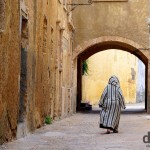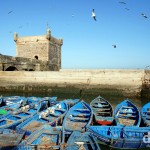Morocco
Thirty-Nine Pictures From As Many Days Of Travel Through Mystical Morocco, One Of The Most Picturesque Countries On Earth
In the lanes of the blue Old Town Medina, Chefchaouen. May 30, 2014
Morocco, the northwest African kingdom (constitutional monarchy) with a largely Muslim population, had been on my radar for a while. The country had been intriguing me for years, as it would anyone who travels with photography in mind. I finally got to spend some time in the country this year, arriving in Casablanca from the Arabian Peninsula in late April.

Hassan II Mosque, Casablanca, Morocco. April 28th, 2014.
The Plan
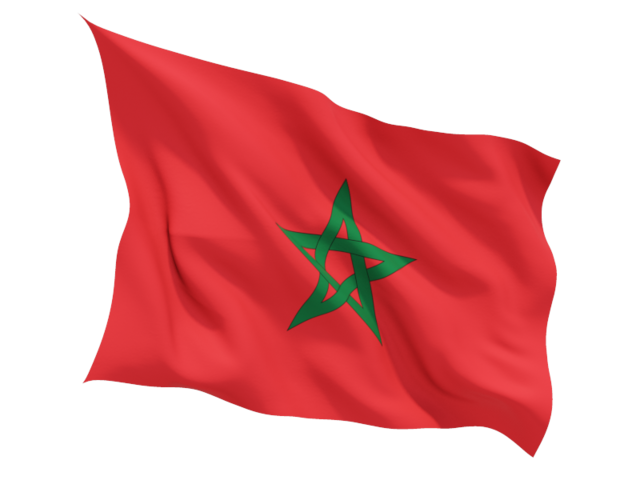 The plan from the outset was to spend at least a month touring the country in an anticlockwise loop from Casablanca & heading south down the Atlantic coast, inland over the Atlas Mountains & through southern oases & palmeries towards the Sahara & the border with Algeria, before turning north back towards Europe via the country’s ancient imperial capitals. That’s exactly how my route went and in doing so I got a nice sampling of what Morocco has to offer, which is a lot: I relaxed at laid-back Atlantic fishing resorts; I lost myself wandering numerous old streets & markets (souqs) in ancient imperial capitals like Marrakesh, Fes & Menkes; I hiked in the High Atlas; I drove the southern oases & palmeries with their ksour of crumbling buildings; I struck out over, and chilled among, towering Saharan sand dunes; I ogled at the country’s gorgeous & often unique architecture (crumbling mud-brick kasbah, dazzling square mosque minarets, homely riads & gorgeous zellij, stucco & carving on medieval Arab buildings); and I embraced the country’s cafe culture, a holdover from French colonial times, watching football/soccer with the locals over cafe au liat & mint tea, a.k.a. Moroccan whisky, in (staunchly male dominated) cafes. It was quite the trip. A true travel highlight.
The plan from the outset was to spend at least a month touring the country in an anticlockwise loop from Casablanca & heading south down the Atlantic coast, inland over the Atlas Mountains & through southern oases & palmeries towards the Sahara & the border with Algeria, before turning north back towards Europe via the country’s ancient imperial capitals. That’s exactly how my route went and in doing so I got a nice sampling of what Morocco has to offer, which is a lot: I relaxed at laid-back Atlantic fishing resorts; I lost myself wandering numerous old streets & markets (souqs) in ancient imperial capitals like Marrakesh, Fes & Menkes; I hiked in the High Atlas; I drove the southern oases & palmeries with their ksour of crumbling buildings; I struck out over, and chilled among, towering Saharan sand dunes; I ogled at the country’s gorgeous & often unique architecture (crumbling mud-brick kasbah, dazzling square mosque minarets, homely riads & gorgeous zellij, stucco & carving on medieval Arab buildings); and I embraced the country’s cafe culture, a holdover from French colonial times, watching football/soccer with the locals over cafe au liat & mint tea, a.k.a. Moroccan whisky, in (staunchly male dominated) cafes. It was quite the trip. A true travel highlight.

Tanneries Chouwara, Fes el Bali, Fes, Morocco. May 29th, 2014.
Thirty-nine days I spent in the country all told. I took a lot of pictures in those 39 days (Morocco more than lived up to its photogenic billing), a selection of which I blogged as I went. What follows is a chronological pictorial recap of my time in the country, 39 pictures from 39 days travel in Mystical Morocco.
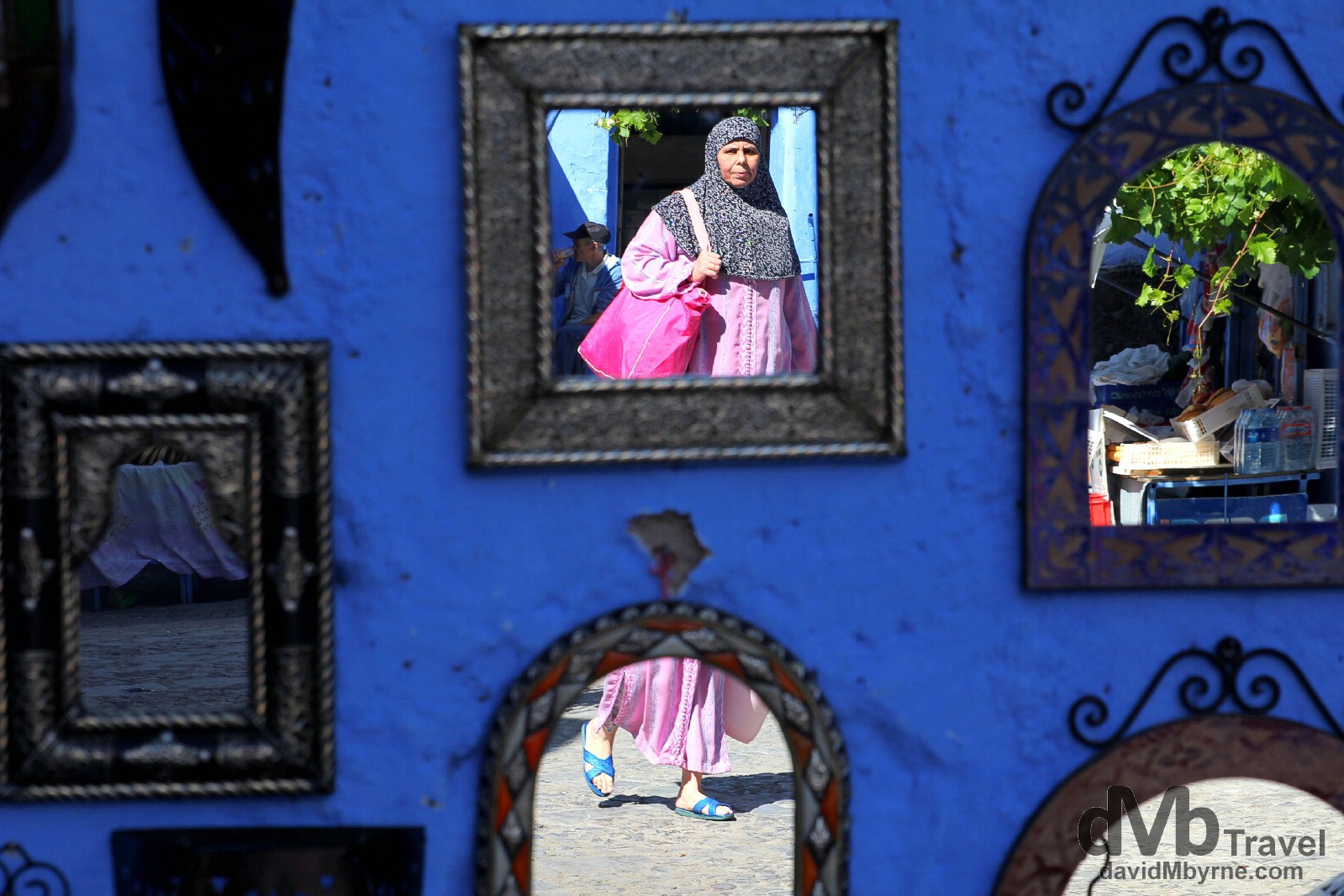
Reflections in mirrors for sale in the lanes of the medina in Chefchaouen, Morocco. June 1st, 2014.
Thirty-nine Pictures from 39 Days

1 || Casablanca was my introduction to Morocco. It’s not the capital (that’s Rabat) but it is the economic & cultural heart of the country, a sprawling metropolis full of traffic jams, French-era colonial buildings, palm tree-lined boulevards, & people, the kind of rough around the edges place that could scare less travelled types. In a city not endowed with notable sights, Morocco’s late King Hassan II wanted give Casablanca a landmark and so had this behemoth constructed, The Hassan II Mosque, the third largest in the world. Built between 1980 & 1993 on reclaimed land – echoing the verse from the holy Quran that states God’s throne was built upon the water – and with an interior that can accommodate 25,000 worshipers, it has centrally heated, see-through floor and retractable roof & was worked on my a team of some 6,000 craftsmen. Casablanca, Morocco. April 28, 2014.

2 || The Atlantic bashing a section of the harbour wall in Casablanca, Morocco. April 28, 2014.

3 || Colonial architecture, remnants of the past when the French were here, & traffic, including grand taxis (all Cold War-era Mercedes), on the streets of Casablanca, Morocco. April 28, 2014.
• From the posting Casablanca, Morocco.

4 || El Jadida is a small fishing town on the Atlantic Coast about 2 hours south of Casablanca. There’s not a whole lot going on here, which is El Jadida’s draw, but it does have a UNESCO-listed attraction, the Cite Portugaise, a small seaside fort that’s a compact maze of twisting streets surrounded by ochre ramparts. It was built by the Portuguese who sniffed around Morocco until they left in 1769. El Jadida, Morocco. May 1, 2014.

5 || Citerne Portugaise, my pictorial highlight of El Jadida’s Cite Portugaise, is a vast, eerie, atmospheric vaulted cistern lit by a single shaft of light. Cite Portugaise, El Jadida, Morocco. May 1, 2014.

6 || Reflections on the bus leaving El Jadida en route to Essaouira, Morocco. May 2, 2014.
• From the posting El Jadida, Morocco.

7 || Essaouira is the blustery Moroccan Atlantic coast’s most historic port & fortified town all in one. Firmly on the tourist trail, it packs a lot in – a bustling fishing port, a lazy beach, & a late 18th-century UNESCO-listed walled medina, the town’s main event, a labyrinth of narrow streets & alleys full of shops, workshops, cafes & colourful, whitewashed houses with heavy wooden doors & clay pots. It’s an especially exhausting place to bring a camera. The classic postcard shot of Essaouira is of the blue boats tied up in its port, some of which are seen here. Essaouira, Morocco. May 3rd, 2014.

8 || Walking outside the walls of the UNESCO World Heritage listed medina in Essaouira, Morocco. May 3rd, 2014.

9 || Essaouira, Morocco. May 4th, 2014.
• From the posting Essaouira, Morocco.

10 || As the most important of Morocco’s four former imperial capital cities, Marrakesh boasts some of the country best architecture, its busiest markets (souqs) & some of Morocco’s best accommodation options. Staying in a Riad, a traditional Moroccan house, typically one with a roof terrace & set around an internal garden, is a quintessential part of any trip to Morocco. I stayed in various riads throughout the country with my favouririte being this, Riad Amlal, where I called home for the time I spent in Marrakesh. Riad Amlal, Marrakesh, Morocco. May 5th, 2014.

11 || The 14th century Ali ben Youssef Medersa, a medersa being an educational institution and this place, used to be the largest Quranic learning centre in Northern Africa. Now it’s one of the most popular tourist attractions in Marrakesh. Ali ben Youssef Medersa, Marrakesh, Morocco. May 6th, 2014.

12 || Wonderful zellij – decorative, patterned tile work – in the arcaded inner courtyard of Mnebhi Palace, home to the Musee de Marrakech, Morocco. May 6th, 2014.

13 || In one of the countless souqs (covered markets) in Marrakesh. The city seems to be one big – BIG – maze of labyrinthine alleyways making & selling all manner of crafts, spices, nicknacks. Anything really. Marrakesh, Morocco. May 8th, 2014.
• From the posting Marrakesh, Morocco.

14 || All roads in Marrakesh lead to the Djemma El-Fna, the city’s UNESCO-listed main square. A scene of public executions in the past (Djemma el-Fna means ‘assembly of the dead’), today the square resembles a large car park, one that resembles an open-air circus; it is alive most hours of the day with people, snake charmers, monkey handlers, henna tattoo artists, musicians, horse-drawn carriages, food & juice stalls, donkey carts, peddlers & general mayhem. At night acrobat artists join the mix, keeping alive a 1000-year-old tradition of street theatre. The food stalls erected nightly in the centre of the Djemma El-Fna, Marrakesh, Morocco. May 11th, 2014.
• From the posting Marrakesh, Morocco || After Dark.

15 || Morocco’s Atlas mountain range, one of the country’s most popular trekking destinations, stretches for 2,500 kilometres across not only Morocco but also into parts of Algeria & Tunisia. The highest peak of the range is the 4,167-metre Jebel Toubkal, the highest peak in north Africa. It’s a 22 kilometre, 2-day slog to get to the summit but once you do the views are pretty special. Jebel Toubkal,, High Atlas, central Morocco. May 12th, 2014.
• From the posting Jebel Toubkal, Morocco.

16|| Ouarzazate, Morocco’s Hollywood (or Ouallywood), is located in the southern oasis of the Moroccan pre-Sahara, a hot region of dust, arid rock & scrub wasteland that the indigenous Berber call hammada. The region is dotted by quintessential Moroccan kasbah, a massive ochre straw & mud-clay brick construction. I captured this picture in the lanes of the Kasbah Taourirt in Ouarzazate, the first of many kasbah I would explore during my time in the country. Ouarzazate, Morocco. May 13th, 2014.
• See more from the posting Ouarzazate, Morocco.

17 || Camels resting in the Parched Oued Ounila riverbed fronting the UNESCO-listed Ait Benhaddou, a short distance from Ouarzazate. Ait Benhaddou was granted UNESCO World Heritage listed status in 2004 in recognition of it being the outstanding representative of the extraordinary mud-brick desert architecture of the Moroccan south. Morocco. May 14th, 2014.
• From the posting Ait Benhaddou, Morocco.

18 || The box-like constructions of the village of Tizgui at the entrance to Todra Gorge (seen in the distance), a trench through the High Atlas which at its deepest point has 300-metre high towering rock walls. Morocco, May 16th, 2014.
• See more at the posting Dades & Todra Gorge, Morocco.

19 || Reflections on the streets of Tinerhir, Morocco. Captured as I was sitting on the side of the road waiting for the bus. May 17th, 2014.
• From the posting Morocco || Getting Around.

20 || The Erg Chebbi sand dunes (erg means sand dune), near the village of Merzouga & not too far from the (closed since 1994) border with Algeria, are Morocco’s most impressive dunes & one of the country’s biggest draws. They occupy an area of land some 30 kilometres north to south and are only 7 kilometres wide at their widest point. Although not as imposing or as expansive as dunes found elsewhere in North Africa, the Erg Chebbi dunes still give an impressive taste of the Sahara’s grandeur. This picture was captured shortly after sunrise on my first morning among the Moroccan desert dunes. Erg Chebbi, Morocco. May 19th, 2014.

21 || A sunrise camel train reflection in the desert of Erg Chebbi, Morocco. May 19th, 2014.

22 || Walking on the sand dunes of Erg Chebbi outside the village of Merzouga, Morocco. May 19th, 2014.

23 || A camel, a ship of the desert, in the grounds of Hotel Haven la Chance, Merzouga, Morocco. May 22nd, 2014.
• From the posting Erg Chebbi, Morocco.

24 || Rissani is a dusty town on the edge of the desert that was, from the 8th to 14th centuries, the location of Sijilmassa, the first independent kingdom of the Moroccan south. It was also from here, in the last 17th century, that the present-day ruling Alaouite dynasty launched its ultimately successful bid for power. Rissani’s heyday has long since passed but remnants of its past glories remain dotted around the region, conveniently accessed via a so-called so-called Circuit Touristique, a 21-kilometre loop to & from Rissani that passes through numerous ksour & palmeries. One of the most impressive ksour (southern villages or tribal strongholds) in the area around present-day Rissani is this, Ksar Oualad Abdelhalim. It was built around 1900 by the then Sultan for his brother who he appointed governor of the southern region. Rissani, Morocco. May 22nd, 2014.
• From the posting Circuit Touristique, Rissani, Morocco.

25 || The most manageable of Morocco’s 4 imperial capitals, UNESCO-listed Meknes is a city endowed with over 45 kilometres of huge walls housing some 20 monumental gates and enclosing about 50 place complexes. It’s home to this, the gateway Bob Mansour, probably Morocco’s most impressive imperial gate. The distinctive pointed horseshoe arch is a quintessential Moroccan sight, one of many architectural styles brought to Morocco from the Middle East by the Arabs. Meknes, Morocco. May 23rd, 2014.

26 || Late afternoon shadows in Place el Hedim, Meknes, Morocco. May 23rd, 2014.
• From the posting Meknes, Morocco.

27 || Moulay Idriss, perched one either side of a small valley, is Morocco’s holiest town and last in the country to fully open its arms to tourists. This is a sunset capture as seen from the grand terrase (grand terrace) on my last night in the town. Moulay Idriss, Morocco. May 26th, 2014.
• From the posting Moulay Idriss, Morocco.

28 || Only 5 kilometres from Moulay Idriss sits this, the UNESCO-listed Roman ruins of Volubilis, the Roman Empire’s most southern & remote outpost & the best preserved archaeological site in Morocco. The Roman ruins at Volubilis, northern Morocco. May 25th, 2014.
• From the posting Volubilis, Morocco.

29 || The most ancient of Morocco’s four imperial capitals and the most complete medieval city of the Arab world, Fes is a place that has dominated Moroccan trade, culture & religious life for over a thousand years. Being home to Morocco’s most exhaustive souks (markets) & some of the country’s most impressive buildings makes it one of Morocco’s most photogenic cities. This is a picture of one of the impressive entrance gates to the Royal Palace in the Fes el Djedid area of the city. Fes, Morocco. May 28th, 2014.

30 || Mint tea, a.k.a. Moroccan Whiskey, in the medina in Fes, Morocco. May 27th, 2014.

31 || The pits of the Tanneries Chouwara, Fes el Bali, Fes, Morocco. May 29th, 2014.

32 || Derb Mechattin, Fes el Bali, Fes, Morocco. May 29th, 2014.
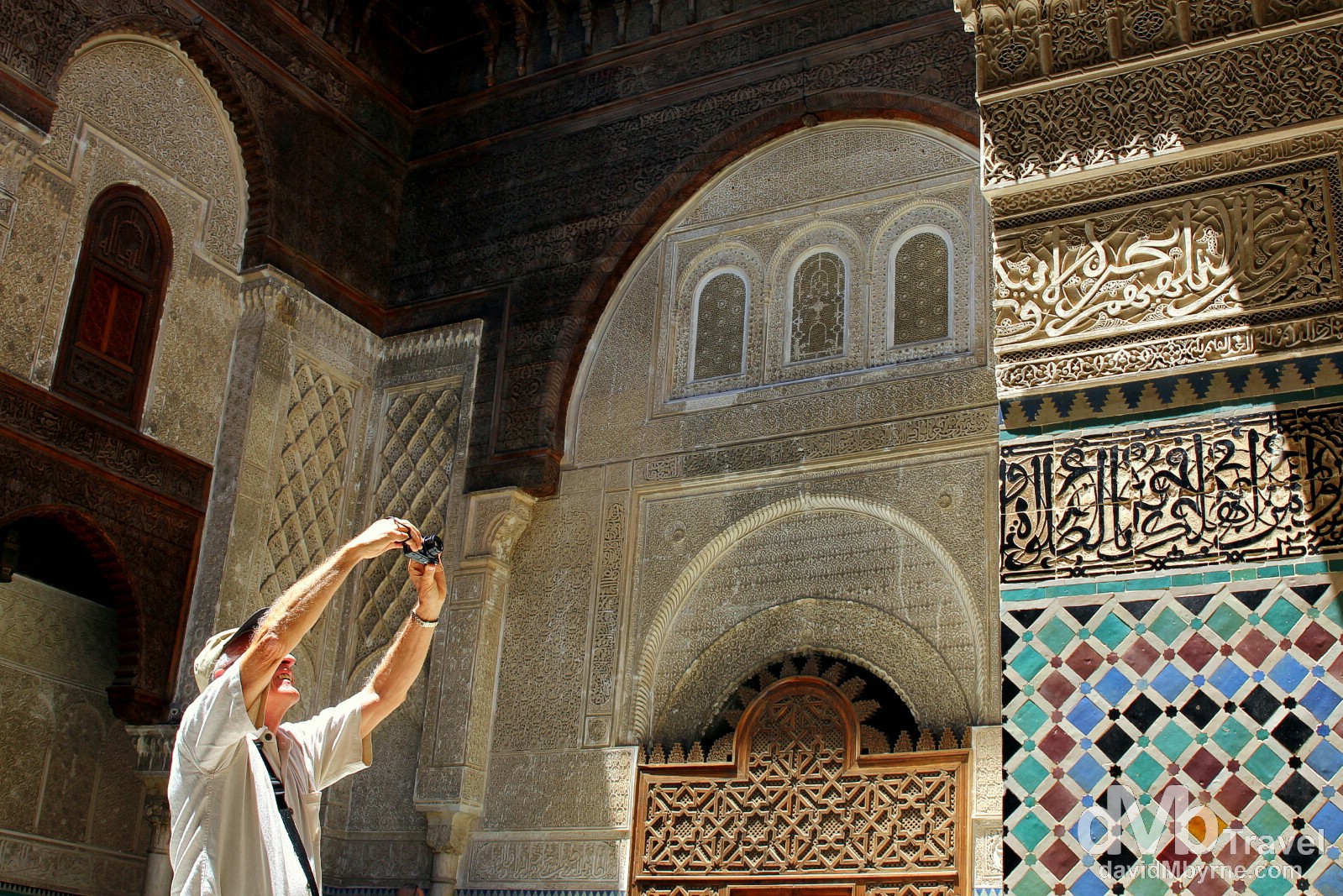
33 || Medersa el Attarin, Fes el Bali, Fes, Morocco. May 29th, 2014.
• From the posting Fes, Morocco.

34 || Chefchaouen in Morocco’s Rif Mountains, might just be Morocco’s tourist central. Tourists come here in droves to appreciate its array of pretty parks, its peaceful little café-culture squares, its quirky guesthouses, & its tiny kasbah. But all that aside, most come here to wander the mind-bogglingly photogenic blue & white-washed walls of the Old Town’s medina. Chefchaouen, Morocco. May 30th, 2014.

35 || In the blue lanes of the medina in Chefchaouen, Morocco. May 31st, 2014.

36 || Reflections in mirrors for sale in the lanes of the medina in Chefchaouen, Morocco. June 1st, 2014.
• From the posting Chefchaouen, Morocco.

37 || Tetouan is a little different. Founded by Muslim & Jewish refugees fleeing the Christian reconquest of Andalusia in southern Spain. They brought with them the look of Moorish Andalusia – tiled lintels, wrought-iron balconies & shuttered windows – a look reflected in the architecture of the Tetouan medina & a look unique to a Moroccan city. This is a picture I captured in the lanes of the medina, one of colourful chicks for sale. Teotuan, Morocco. June 2nd, 2014.
• From the posting Tetouan, Morocco.

38 || Tangier the so-called Gateway to Africa, is a city with a storied past and mixed reputation. The city, my last stop in the country, has a obvious seedy underbelly and it wasn’t somewhere I warmed to. As the first stop for many in Morocco, Tangier unfortunately is not a good introduction to the country. However, fortunately it’s not representative of the rest of Morocco either. Rue Sidi Bouabid, Tangier, Morocco. June 3rd, 2014.

39 || Gazing across the 15 kilometer Strait of Gibraltar to southern Spain (& Europe) from the walls of the medina in Tangier, Morocco. June 3rd, 2014.
• From the posting Tangier, Morocco.
Morocco – A Look Back || The Gallery
- Hassan II Mosque, Casablanca, Morocco. April 28th, 2014.
- The Atlantic bashing a section of the Casablanca harbour wall as seen from the Hassan II Mosque. Casablanca, Morocco. April 28th, 2014.
- Casablanca, Morocco. April 28th, 2014.
- In the lanes of the UNESCO-listed Cite Portugaise, El Jadida, Morocco. May 1st, 2014.
- Citerne Portugaise, Cite Portugaise, El Jadida, Morocco. May 1st, 2014.
- Reflections on the bus leaving El Jadida en route to Essaouira, Morocco. May 2nd, 2014.
- A section of the port of Essaouira, Morocco. May 3rd, 2014.
- Walking outside the walls of the UNESCO World Heritage listed medina in Essaouira, Morocco. May 3rd, 2014.
- Essaouira, Morocco. May 4th, 2014.
- Riad Amlal, Marrakesh, Morocco. May 5th, 2014.
- Ali ben Youssef Medersa, Marrakesh, Morocco. May 6th, 2014.
- The arcaded inner courtyard of Mnebhi Palace, home to the Musee de Marrakech, Morocco. May 6th, 2014.
- In a section of the souq in Marrakesh, Morocco. May 8th, 2014.
- The food stalls erected nightly in the centre of the Djemma El-Fna, Marrakesh, Morocco. May 11th, 2014.
- The early morning view from the 4,176-metre summit of Jebel Toubkal, the highest point in Northern Africa. High Atlas, central Morocco. May 12th, 2014.
- In the lanes of the Kasbah Taourirt in Ouarzazate, Morocco. May 13th, 2014.
- Camels resting in the Parched Oued Ounila riverbed fronting the UNESCO-listed Ait Benhaddou in southern Morocco. May 14th, 2014.
- The village of Tizgui at the entrance to Todra Gorge, Morocco, May 16th, 2014.
- Reflections on the streets of Tinerhir, Morocco. May 17th, 2014.
- Taking in sunrise on the red sands of the Erg Chebbi sand dunes in Morocco. May 19th, 2014.
- A sunrise camel train reflection in the desert of Erg Chebbi, Morocco. May 19th, 2014.
- Walking on the sand dunes of Erg Chebbi outside the village of Merzouga, Morocco. May 19th, 2014.
- A camel in the grounds of Hotel Haven la Chance, Merzouga, Morocco. May 22nd, 2014.
- Ksar Oualad Abdelhalim, Rissani, Morocco. May 22nd, 2014.
- The gateway Bob Mansour in Meknes, Morocco. May 23rd, 2014.
- Late afternoon shadows in Place el Hedim, Meknes, Morocco. May 23rd, 2014.
- Sunset as seen from the grand terrase (grand terrace) in Moulay Idriss, Morocco. May 26th, 2014.
- The UNESCO-listed Roman ruins of Volubilis, northern Morocco. May 25th, 2014.
- One of the impressive entrance gates to the Royal Palace in Fes el Djedid, Fes, Morocco. May 28th, 2014.
- Mint tea, aka Moroccan Whiskey, in the medina in Fes, Morocco. May 27th, 2014.
- The pits of the Tanneries Chouwara, Fes el Bali, Fes, Morocco. May 29th, 2014.
- Derb Mechattin, Fes el Bali, Fes, Morocco. May 29th, 2014.
- Medersa el Attarin, Fes el Bali, Fes, Morocco. May 29th, 2014.
- Walking in the blue lanes of the medina in Chefchaouen, Morocco. May 30th, 2014.
- In the blue lanes of the medina in Chefchaouen, Morocco. May 31st, 2014.
- Reflections in mirrors for sale in the lanes of the medina in Chefchaouen, Morocco. June 1st, 2014.
- Colourful chicks for sale in the medina in Teotuan, Morocco. June 2nd, 2014.
- Rue Sidi Bouabid, Tangier, Morocco. June 3rd, 2014.
- Gazing across the 15 kilometer Strait of Gibraltar to southern Spain (& Europe) from the walls of the medina in Tangier, Morocco. June 3rd, 2014.




